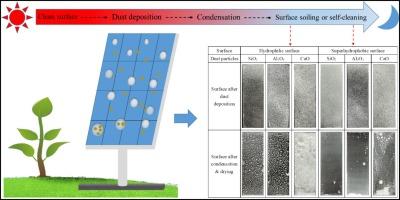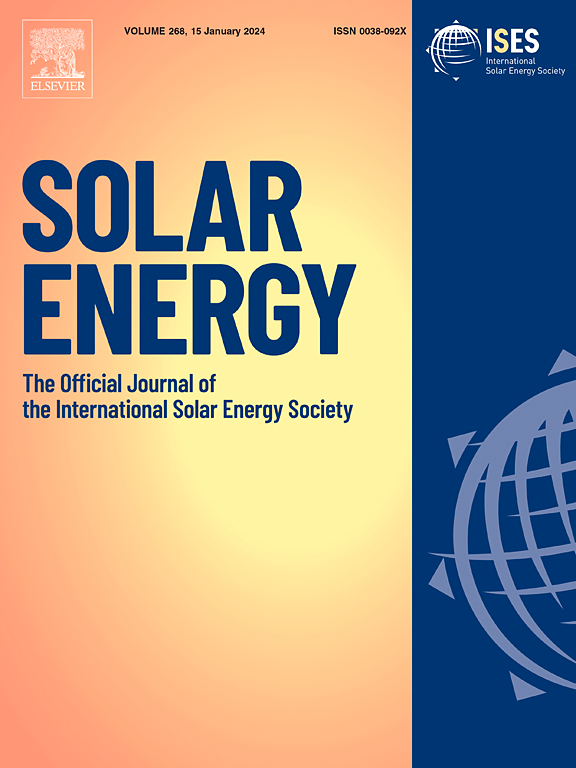An analysis of surface-soiling and self-cleaning of photovoltaic panel under condensation
IF 6
2区 工程技术
Q2 ENERGY & FUELS
引用次数: 0
Abstract
Dust on the PV surface is well known to cause significant losses in energy yield. Complex physical and chemical interactions occur between dust and condensate on the surface of PV module under condensation, which determine the mode and severity of surface contamination. In this work, dynamic behavior of dust particle on surface is investigated from a microscopic perspective. Dust mainly experiences particle aggregation, dusty droplet coalescence, growth, movement and drying. After condensation & drying, surface transmittance is quantitatively measured to provide an assessment of surface contamination. The results show that for SiO2 and Al2O3 particles, that do not react with condensate, surface transmittance increases after drying, especially for superhydrophobic surface (SHS). However, CaO particle easily react with condensate and atmospheric carbon dioxide to form insoluble substances. After drying, a dense layer of dust is formed on the hydrophilic surface with transmittance of 49.2 %. SHS has excellent ability of self-cleaning and it increases with extension of condensation time. As condensation time is 120 min, transmittance of SiO2-contaminated SHS can recover to 99.1 % of clean surface. This finding may guide for development of suitable strategies to prevent or mitigate surface-soiling under condensation.

冷凝条件下光伏板表面污垢和自清洁分析
众所周知,光伏组件表面的灰尘会导致能量损失。在冷凝状态下,光伏组件表面的灰尘和冷凝水之间会发生复杂的物理和化学作用,从而决定了表面污染的模式和严重程度。本研究从微观角度研究了灰尘颗粒在表面的动态行为。灰尘主要经历颗粒聚集、尘滴凝聚、生长、运动和干燥。在凝结和amp;干燥后,定量测量表面透射率,以评估表面污染情况。结果表明,对于不与冷凝液发生反应的 SiO2 和 Al2O3 颗粒,干燥后表面透射率会增加,尤其是对于超疏水表面(SHS)。然而,CaO 颗粒很容易与冷凝水和大气中的二氧化碳发生反应,形成不溶性物质。干燥后,亲水表面会形成一层致密的灰尘,透光率为 49.2%。SHS 具有出色的自洁能力,而且随着冷凝时间的延长,自洁能力也会增强。当冷凝时间达到 120 分钟时,被二氧化硅污染的 SHS 的透射率可恢复到清洁表面的 99.1%。这一发现可为开发合适的策略提供指导,以防止或减轻冷凝条件下的表面污垢。
本文章由计算机程序翻译,如有差异,请以英文原文为准。
求助全文
约1分钟内获得全文
求助全文
来源期刊

Solar Energy
工程技术-能源与燃料
CiteScore
13.90
自引率
9.00%
发文量
0
审稿时长
47 days
期刊介绍:
Solar Energy welcomes manuscripts presenting information not previously published in journals on any aspect of solar energy research, development, application, measurement or policy. The term "solar energy" in this context includes the indirect uses such as wind energy and biomass
文献相关原料
公司名称
产品信息
阿拉丁
Aluminum oxide (Al2O3)
阿拉丁
Silica (SiO2)
 求助内容:
求助内容: 应助结果提醒方式:
应助结果提醒方式:


